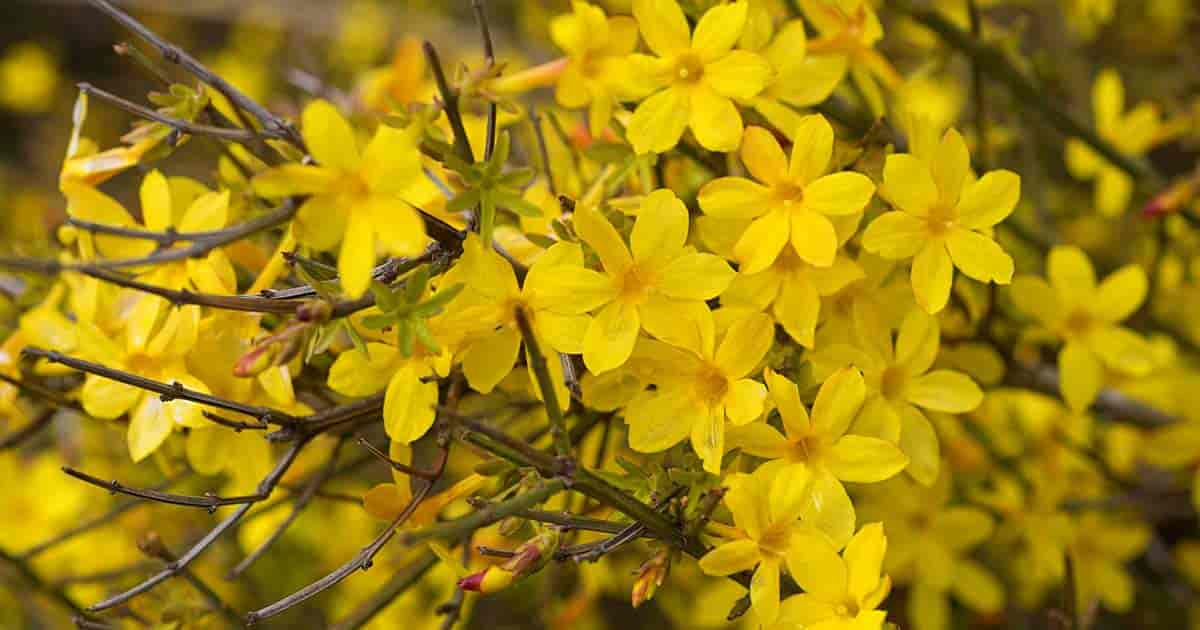Jasminum Nudiflorum is a slender, deciduous shrub native to Northern China. Winter jasmine its common name belongs to the family Oleaceae (olive family).
English botanist John Lindi first described the plant, in the 1846 Journal of the Horticultural Society of London.

The distinctive characteristics of Yellow winter-flowered jasmine include:
- Long, arching bright green colored branches
- Deep, emerald green colored pinnate leaves
- Small non-edible berries, which turn black when ripe
Nudiflorum is also known as Jasminum sieboldianum. It has been widely grown in France and some areas of the United States.
Winter Jasmine Care
Size & Growth
Jasminum nudiflorum is a trailing shrub growing up to 10’ feet in height and can spread up to the same width.
It typically starts growing from a central crown and then becomes a sprawling mound with arching branches.
The best time for planting winter jasmine is Fall as it helps and promotes proper development of stems root.
However, if planted in other seasons, avoid very hot and freezing weather.
First-year stems of winter jasmine are bright green.
Flowering and Fragrance
As evident from the name, the plants bloom time starts in winter months.
The flowering season of Jasminum nudiflorum starts from November and lasts till March, which is why it is also called Yingchun in Chinese, meaning the flower which welcomes spring.
The solitary bright yellow flowers appear on bare stems, hence the name nudiflorum meaning naked flower.
The small star-shaped flowers are non-fragrant and appear before the leaves.
Light & Temperature
The Jasminum nudiflorum plant can grow in full sun as well as partial shade.
While it can tolerate full shade, it will reduce the flowering.
According to experts, the plant flowers best in full sun.
Although it is a hardy plant, it cannot tolerate temperatures lower than 5° degrees Fahrenheit (-15° C).
USDA hardiness zone 6 – 10.
Watering and Feeding
Jasminum nudiflorum requires adequate watering to bloom well.
However, you need to be careful and not overwater the plant, especially in the fall season, as it is detrimental for it.
The water needs of winter jasmine are highest during early spring through summer.
It is best to water it 2-3 times a week, especially during hot weather.
But, gradually reduce the frequency of watering as the weather starts to change.
Though to late winter, this jasmine species only needs to be watered once a week.
To increase the growth of the plant, add fertilizer after every two weeks, during spring and summer.
However, make sure to not add any fertilizer when the plant is blooming.
Soil & Transplanting
While winter jasmine can grow in any soil, it thrives in sandy loams with regular moisture and well-drained.
However, it can survive in poor soils and dry sites.
Grooming and Maintenance
Winter jasmine plants are easy to grow plants and don’t need much maintenance.
It does not need regular pruning, but it can help tidy it up or keep its shape.
Sometimes, prune the plant to prevent bare patches.
Since it is a hardy plant, it can tolerate hard pruning.
The best time for pruning is in spring; immediately after the end of the flowering season.
How to Propagate Winter Jasminum?
The propagation techniques used for Jasminum nudiflorum are:
Layering:
- Layering is performed in various ways.
- The simplest technique is to select a few young and flexible shoots to easily be bent down to the ground.
- Preferably, they should be on the outer side of the plant.
- Leaving a distance of about 1’ foot from the tips of shoots, make 1” – 2” inch long incisions along the stem.
- Now apply a hormone rooting compound on both the surfaces of the incisions, put layered areas of the green stems in shallow trenches, no more than 4” – 6” inches deep, and fasten them with a bamboo cane.
- Fill the trench with soil and water, if dry.
- The trailing branches of the plant root when they come in contact with soil.
Semi-Hardwood Cuttings:
- To take semi-hardwood cuttings, use sharp, clean hand pruners and choose healthy material from the season’s growth.
- Place the cuttings in a plastic bag and put the bag in a hot or shaded area for a few hours.
- However, do not leave the cuttings for more than 12 hours.
- When ready to plant, trim the cuttings into 4” – 6” inch pieces; cut just below the leaf node.
- Remove any soft tips and lowest green leaves and dip them in fresh root hormone powder from the bottom.
- Plant the cuttings in a container filled with cuttings compost and water well.
- Allow them to drain and then place the pots in a greenhouse.
- Semi-hardwood cuttings are best to take in the morning.
Control weed issues with mulch.
Winter-flowered Jasmine Pest or Diseases
Winter jasmine stays disease-free; however, it may get affected by mealybugs and aphids.
No toxic effects of Jasminum nudiflorum have so far been reported.
Winter Jasmine Uses
Jasminum nudiflorum is cultivated for ornamental purposes in gardens, terraces, and as covers for slopes and banks.
It is also considered an ideal choice for wall-side borders and fences; however, it needs support and tying-in to grow on a vertical framework.
Winter jasmine is also grown as a bonsai. It makes a good ground cover, beautiful in a winter landscape. As a climbing plant use it to cover up walls or train as a flowering vine for a trellis.
Searching for a winter jasmine companion plant? Consider the Clematis vine, Hydrangea, or Forsythia shrubs.
